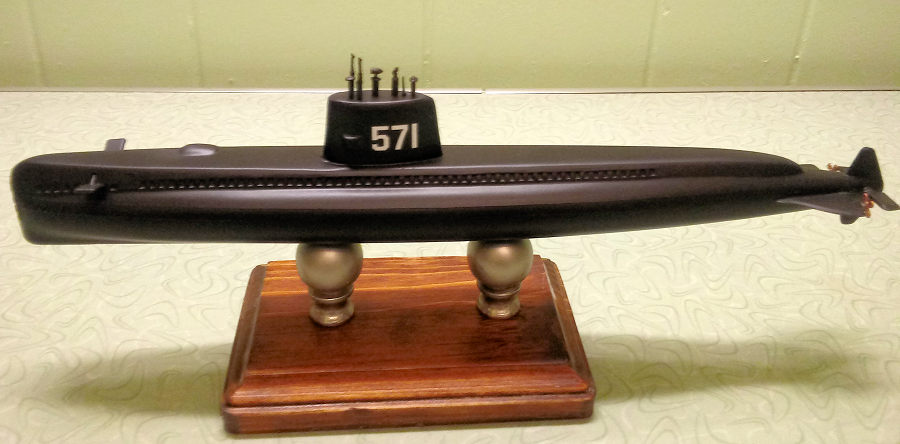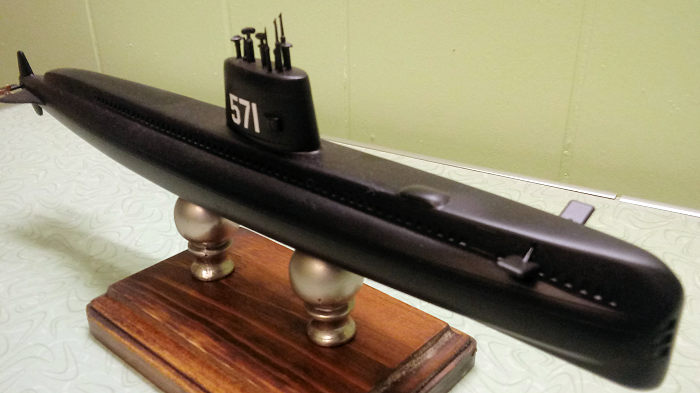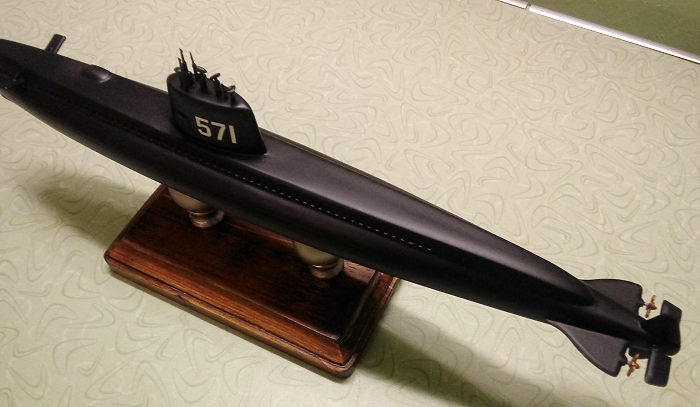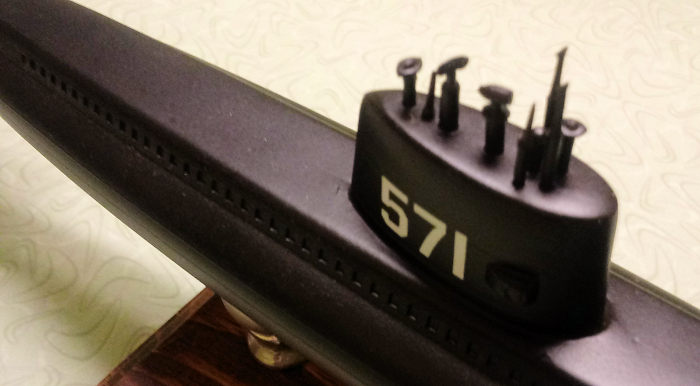
| KIT #: | 70884 |
| PRICE: | $13.00 |
| DECALS: | One option |
| REVIEWER: | Christopher Campbell |
| NOTES: | Quick, Easy, Fun, and Nostalgic |

| HISTORY |
The first serious proposal to build a nuclear powered submarine date back to 1950 as project SCB-64. Her construction was authorized by congress in 1951 and began the next year. From the beginning, the project was spearheaded by then Captain Hyman G. Rickover, the father of the nuclear navy. Though she was the fourth U.S. Navy vessel and second submarine to bear the name Nautilus, there was doubtless at least some nod given to Captain Nemo’s marvelous submarine from Jules Verne’s novel 20,000 Leagues Beneath the Sea. This was, after all, the absolute cutting edge of technology and virtually science fiction brought to life.
Nautilus benefitted from extensive wartime experience gained with older Gato and Balao and Tench class submarines as well as their postwar improvements. In the immediate postwar years, steps were being taken towards revolutionizing submaine design and function under the Navy’s GUPPY (Greater Underwater Propulsion Power) program. This included both physical and mechanical changes to existing design that were, at the time, the pinnacle of U.S. submarine design. Most obvious was the deletion of deck guns and anything unnecessary mounted on the hull that caused underwater drag as well as two different configurations of improved sail, making them as sleek as possible. Additional improvements included the addition of snorkels, improved ventilation, and higher battery capacity to improved speed and duration while submerged.
Launched in 1954, the Nautilus first set sail under nuclear power on January 17, 1955. She was the first ship in history to accomplish such a feat and paved the way for host of submarines and surface ships to follow, not only from the United States, but other nations as well. In 1958, she became the first of many nuclear powered submarines to pass under the North Pole ice cap, finally accomplishing the fabled and elusive “Northwest Passage.” Throughout the 1950’s and early 1960’s, Nautilus was a record breaker and earth shaker, accomplishing feats of underwater navigation and distance records that were unimaginable less than a decade earlier. She toured the world and was a showboat for United States Navy and the burgeoning technology of nuclear propulsion.
The new tech was quickly proven and became the envy navies around the globe, some of which would soon begin constructing their own nuclear powered boats. By the end of the next decade nuclear powered boats would become commonplace as both attack submarines and “boomers” carrying sub launched nuclear missiles. This trend shows no sign of abating. Though many nations are now producing or operating exceptional non-nuclear boats, such as the exceptional South Korean Navy Dosan Ahn Chango boat and German designed Type 212 and 214 boats, nuclear propulsion remains the gold standard that navies around the globe aspired to for ocean going subs, whether attack or missile oriented.
While a record breaker and pioneer, Nautilus was soon surpassed in her capabilities by subsequent classes of U.S. Navy as well as foreign nuclear boats. Almost as quickly as she had come to the forefront on submarine design, obsolescence began to beckon. Sadly, just a decade after her maiden voyage, the Nautilus was already past her prime.
Submarine technology was improving by leaps and bounds. The Thresher and Sturgeon class had introduced cleaner, teardrop hull designs and incorporated lessons learned from Nautilus and other boats, nuclear and non-nuclear powered. Within two short decades, she was now considered noisy and very vulnerable to sonar detection. Ultimately, she could only cruise submerged at 4 knots and remain undetected, making he obsolete While she would continue to serve, it would mostly be in a second line role. She was ultimately decommissioned in 1980 after twenty-six years of service.
Today she, quite appropriately, a museum vessel in New London, Connecticut where she attracts thousands of visitors annually. There could be no more appropriate end for so historic a vessel. I personally have toured many museum ships, though this is one that I have not yet had the pleasure of, though I hope to soon.
| THE KIT |
Originally released in 1954, Lindberg’s Nautilus was the third kit of the legendary boat. Revell and Aurora had beaten then to the market by one year with their own kits listed as 1:305 scale and 1:242 scales respectively. Lindberg’s kit is listed as 1:300 scale is dimensionally very similar to the Revell, though they are unquestionably different molds. (I have not actually scaled out either kit by for exact dimensional accuracy and in this case I am basically taking the manufacturers at their word. Likewise, I have never compared the two kits side by side, though I have looked at both plenty of times. However, while there may have been some influence from Revell on the Lindberg kit, it is definitely an Lindberg “original.”) The Revell kit featured a deck mounted cannister for carrying the Loon (U.S. V-1 copy) or other missile or payload needing watertight storage, and notably different deck details.
Both kits have been in production periodically since they were first released. The Revell kit has seen far more releases over the years, the most recent being in SSP series 1995, more than a decade after their very well known History Maker’s series release in 1982. The kit built and reviewed here is the latest release under the Lindberg label dating from 2013.
I am not certain when the original 1954 release of the Lindberg kit ceased to be available. I have been building since I was four, so right at fifty years, and I never saw the Lindberg kit prior to its 1990’s incarnation. However, this kit has been commonly available since that time along with their Gato “Fleet Submarine” boat which started life as a Varney mold back in 1945(!).
 It has just been released under the Atlantis Models
brand along with the Gato. I chose the Lindberg kit mainly due to it being
readily available at a very reasonable price, knowing that whichever I chose, I
would be doing at least modicum of modification to the kit to get a reasonable
representation of the boat that I was satisfied with.
It has just been released under the Atlantis Models
brand along with the Gato. I chose the Lindberg kit mainly due to it being
readily available at a very reasonable price, knowing that whichever I chose, I
would be doing at least modicum of modification to the kit to get a reasonable
representation of the boat that I was satisfied with.
This is a very simple kit, consisting of only twenty-eight parts, including the display stand and a rather large (and inaccurate) clear part for the sail. Four of these parts are comprised of an odd, futuristic looking missile, which is presumably some interpretation of the Regulus II, that had not yet seen the light of day, a deck gun(!), and W.W.II style wood deck. These last parts notwithstanding, you have a pretty decent, basic kit out of the box that has the right shape and basic details for the legendary Nautilus.
While “shake and bake” kits are nice, and easy (at least most of the time), I have long enjoyed taking a kit with decent bones and building something nice out of it. Sometimes, this only takes a little work. Sometimes, like my 1/32 Matchbox SBD or Williams Bros. P-35, there is a ton of work involved. For a modeler with some experience, this can be an enjoyable challenge. At other times it can be an exercise in frustration. This one was pretty easy and enjoyable. While I never built this one as a youth, I have to say that it would have been a breeze.
I was, and still am, quite the Cold War junkie. While my model collection has extensive W.W.II, Korean War, and especially Spanish Civil War models in it, I love Cold War and Atomic Age subjects. I grew up watching Fail Safe, The Bedford Incident, Ice Station Zebra, On the Beach, The Twilight Zone, and many peripherally Cold War films like The Thing from Another World, War of the Worlds, and so on, every time that I had the chance to see them on television. They terrified, fascinated, and thrilled me, and I still enjoy them. (I have Ice Station Zebra playing as I write this.) Needless to say, being both an aircraft and ship enthusiast, I desperately needed a USS Nautilus in my collection. It was a necessary fixture to the room in my house known as the Atomic Lounge.
As for which kit of the Nautilus is the most accurate, I will not presume to say. While both the Revell and Lindberg kits provide a good basis for a model, there are probably better options. For 1:700 scale enthusiasts, there are a number of recent options. There has also been a 1:300 release from Doyusha that I have never seen, but suspect to be a clone of either the Revell or Lindberg kit. While I have never seen it, if I were to venture a guess, I would say that the ultimate kit to date is most likely the 1:200 release from Wektor in 2015
| CONSTRUCTION |
I will start out saying that there is nothing exceptionally challenging in this build to any modeler, novice or otherwise. It was a relatively quick and easy build, and any modeler should be able to achieve the results that I did with moderate experience.
I will openly say that despite my enthusiasm for subjects such as this and ships in general, I am not an authority on the Nautilus and will make no pretenses to be such. This was my second submarine kit. My first one was the Revell release of the Aurora mold of USS Skipjack that I picked up from Propts’ drugstore back when I was in Navy R.O.T.C. at Huntsville High School in Alabama in 1983. I plan to do this kit again, also for my Atomic Lounge. (As a footnote to this, my former R.O.T.C. unit has since transitioned to Air Force R.O.T.C., and just days ago to the nation’s first Space Force R.O.T.C. unit at Huntsville High School. I think that this is great. Though, sadly, it still leaves Huntsville, Alabama, to my knowledge with no U.S. Navy R.O.T.C. option for nearly two decades now.)
The first things that I addressed were related to the deck. So far as I have been able to determine, Nautilus was never fitted or intended to be fitted with a deck gun of any sort. (I have seen a few very early photos that look like there is something a little different on the deck, but I have never seen any clear enough to validate this. If it was ever there, it was deleted from her almost immediately. To me, at least, this was clearly a case of Lindberg adding something that potential customers thought looked like what was supposed to be on a submarine.) Likewise, the same holds true for the missile. While the Nautilus was well known to have test fired the Loon, the missile that is included with a kit looks nothing like anything that the Nautilus ever launched or was ever even in U.S. Navy service. (It looks more like a tiny version of some futuristic jet fighter from a Saturday morning cartoon.)
As mentioned, the wood deck is something that I was highly skeptical of. Some photos that I have found of Nautilus actually seem to show something that might be some sort of wood decking in her earliest incarnations. If it was ever fitted, the vast majority of photos show that it was clearly discarded as soon she began sea trials. All of the pictures that I have seen that showed this were when she was under construction and being fitted out. I think it more likely a temporary structure to give workers a better footing. Again, though, as I said, I am no true authority on the Nautilus.
However, since I intended to build something that represented the USS Nautilus as she was in service during the 1950’s or early 1960’s, I discarded this as well the deck gun and missile, consigning them to the parts drawer labeled “Odd Bits.”
Thus, I began by cementing the two combined hull and
sail sections together with Plastruct Plastic Weld liquid cement. This welded
the two sections nicely and required only moderate filling with t hick CA glue
and sanding. I filled any bits that might have been related to the wood decking
with same gap filling CA glue and then sanded all fills and seams with 320 and
400 grit sandpaper followed by 0000 steel wool.
hick CA glue
and sanding. I filled any bits that might have been related to the wood decking
with same gap filling CA glue and then sanded all fills and seams with 320 and
400 grit sandpaper followed by 0000 steel wool.
In photos from the Internet and Wikipedia showing the Nautilus in service during the 1960’s, I noted a bulge on the starboard bow, slightly aft of the bow and dive planes, which I am informed was a sonar retrofit. There was nothing like this in the kit, so I found a piece from a landing gear cover of from some long ago build in the parts bin that looked about the right size and shape and after some trimming with and X-acto knife, glued and fitted it in place using gap filling CA glue and sanded it until I was satisfied with the fit. I did the same thing with the clear bit for the sail, fitting it and filling and sanding until it was smooth, as she did not have the “solarium,” only some viewing ports.
With this done, I glued the forward dive planes in place as well as the aft planes, rudders, and so on using CA glue and encountered no fit issues. Since there was only one color anticipated for my build, in contrast to some ship and all aircraft builds, I fitted all of the “fiddly parts;” the periscopes, snorkels, antennas, and so on to the sail and made ready to paint her. This sounds quite simplistic, but that is the nature of the kit. Once the hull and sail have been glued and smoothed out, there truly is not all that much to do other than fit these few small pieces. Now, she was ready to paint.
| COLORS & MARKINGS |
I will note here that I have seen several interpretations and photos of various schemes used on Nautilus. These include black upper and red lower hull, grey upper hull over a black lower hull, solid black, and probably at least one more that I am omitting here. I opted for the overall black scheme. It was simple, and from what I could discern, seemed to be the most prevalent one used on Nautilus. This made for a quick and easy session airbrushing it in Testors Model Master Flat Black. While this was drying, I painted her screws in Testors Brass, then set everything aside to dry.
The decals for the sail featured the “571” numerals in simple white, but grossly larger than any photo that I had ever seen of the Nautilus. Instead, I sourced more appropriately sized (though still a little large to my eyes) white numerals from my ample decal stash. After everything was dry, I gave the sail a light coat of Model Master rattle can Gloss and carefully applied these with a light dab of Solvaset to snug them down. Once they had set and cured overnight, I gave everything a coat of Model Master rattle can Semi-Gloss clear coat lacquer (Enjoy it while it lasts!).
| FINAL CONSTRUCTION |
By this time, there was not much left to do. I glued her twin screws in place with a drop of CA glue. I did not want to use the kit stand, as I did not like the look of it, so I opted for a simple wood base from Hobby Lobby that I sanded, stained, and varnished. The I then measured the mounting points on the model and made mounting posts from a pair of silver lamp finals from a hardware store that I thought would give it an appropriately “futuristic” look, perhaps evocative of some whimsical idea of nuclear reactor vessel, even.
I drilled these out and fitted them with a pair of ¼” dowels. The mounting points in the lower hull were opened with a pin vice using bits of gradually increasing size until the mounting points in her keel were sufficiently large to allow the dowels to fit. Once that was done and test fitted, I glued her in place with CA glue. Finally, I have her another coat of the same Semi-Gloss clear coat and was very pleased with the result. I had a completed model of the Nautilus and had completed one of my simplest, most frustration free builds in years.
| CONCLUSIONS |
I am not going to begin to say that I have a super accurate 1/300 USS Nautilus build. However, I have a very nice looking model that generally looks like the boat should. I was satisfied with it and it looks great in my Atomic Lounge. That was good enough for me. On a whim, I took her to a couple of model shows and came away from one with a 2nd. Place award in the ship category, which made me quite happy.
 This was a simple and fun build. I think I spent less
than ten hours on her overall and I am very pleased with the results. Building a
hyper accurate model is great and a commendable feat for any modeler. Having fun
is important, too. This was fun, and it took me back to building models as an
adolescent in an era when there basically were no “shake and bake” kits and you
made the most of what you had. Or, you just had fun taking it out of the box,
putting it together to the best of your ability using the means at your disposal
and being happy with what you got. That is something that we sometimes lose
track of today. I highly recommend that modelers young and old indulge in such
exercises. The rewards are greater more satisfying than you might expect. You
might not win as many awards at shows, but you might have more fun in the
process. I would recommend the Lindberg Nautilus to any modeler, young or old,
who would like to build the great ancestor of all modern nuclear submarines. I
would likewise recommend it to nay modeler as a first kit for getting into the
model ship building business. It is inexpensive, simple, easy, and fun. That is
something that we all need sometimes in this hobby, no matter what your level of
expertise is. It reminds us of what it is: a hobby.
This was a simple and fun build. I think I spent less
than ten hours on her overall and I am very pleased with the results. Building a
hyper accurate model is great and a commendable feat for any modeler. Having fun
is important, too. This was fun, and it took me back to building models as an
adolescent in an era when there basically were no “shake and bake” kits and you
made the most of what you had. Or, you just had fun taking it out of the box,
putting it together to the best of your ability using the means at your disposal
and being happy with what you got. That is something that we sometimes lose
track of today. I highly recommend that modelers young and old indulge in such
exercises. The rewards are greater more satisfying than you might expect. You
might not win as many awards at shows, but you might have more fun in the
process. I would recommend the Lindberg Nautilus to any modeler, young or old,
who would like to build the great ancestor of all modern nuclear submarines. I
would likewise recommend it to nay modeler as a first kit for getting into the
model ship building business. It is inexpensive, simple, easy, and fun. That is
something that we all need sometimes in this hobby, no matter what your level of
expertise is. It reminds us of what it is: a hobby.
| REFERENCES |
https://en.wikipedia.org/wiki/USS_Nautilus_(SSN-571)
https://en.wikipedia.org/wiki/Greater_Underwater_Propulsion_Power_Program
United States Submarines edited by David Randall Hinkle, Harry H. Caldwell, and Arne C. Johnson, published by Sonalysts, Inc. 2002
The Encyclopedia of the World’s Warships by Hugh Lyon, published by Salamander Books, 1978
Jane’s Submarines: The War Beneath the Waves, published by Harper Collins 2001
April 2022 Copyright
ModelingMadness.com. All rights reserved. No reproduction in part or in whole
without express permission. If you would like your product reviewed fairly and fairly quickly, please
contact
the editor or see other details in the
Note to
Contributors.